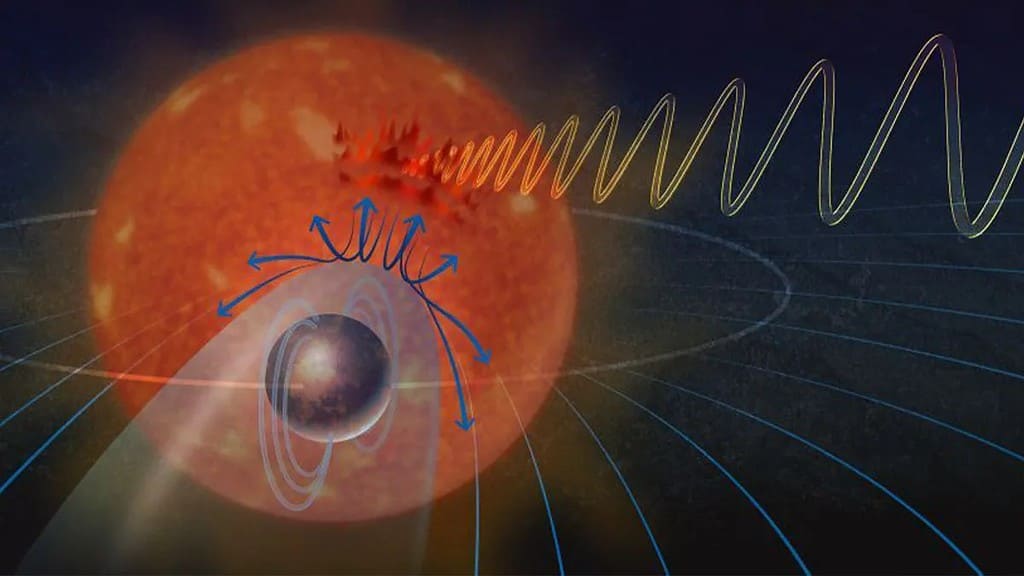The Northern Lights are one of the most beautiful natural events you can witness on Earth. The spectacular light show is the result of interactions between high-energy particles from solar flares colliding in the upper reaches of our atmosphere and then descending along the lines of the planet’s magnetic fields.
But could other Earth-like planets experience the same thing? A new multi-university study published in Nature Astronomy claims it’s a definite possibility, and this bodes well for our search for other Earth-like planets.
Magnetism and life
Our planet owes much of its ability to sustain life to the presence of a magnetic field. This protective shield deflects the sun’s high-energy particles and plasma, which could otherwise destroy our atmosphere and destroy life on Earth.
So if we’re looking for Earth-like planets that could host life on the surface, they’d need to have a magnetic field as well. But planetary magnetic fields are not that uncommon. Every planet in our own Solar System other than Mars and Venus has magnetic fields.
Now, researchers have discovered a potential Earth-sized planet in another solar system via radio signals. This new discovery is different as the planet is more Earth-like than anything in our cosmic vicinity.
Coined YZ Ceti b, the planet could also have a magnetic field like our own and this rocky exoplanet orbits a star about 12 light-years away from our own Pale Blue Dot.
Astrophysicists Sebastian Pineda and Jackie Villadsen utilized the National Science Foundation’s National Radio Astronomy Observatory’s Karl G. Jansky Very Large Array, to examine a recurring radio signal emanating from the star YZ Ceti. Their research was aimed at understanding the magnetic field interactions between distant stars and their orbiting planets.

Joe Pesce, program director for the National Radio Astronomy Observatory, highlights the importance of determining whether rocky exoplanets have magnetic fields in our quest to identify potentially habitable worlds. A planet’s magnetic field plays a critical role in preventing its atmosphere from eroding over time by its star’s particles.
“The search for potentially habitable or life-bearing worlds in other solar systems depends in part on being able to determine if rocky, Earth-like exoplanets actually have magnetic fields,” Pesce said. “This research shows not only that this particular rocky exoplanet likely has a magnetic field but provides a promising method to find more.”
By looking for planets that are very close to their stars and similar in size to Earth, the researchers were able to detect bright radio waves generated by the interactions between the star and the planet’s magnetic field.
“Whether a planet survives with an atmosphere or not can depend on whether the planet has a strong magnetic field or not,” said Pineda, an astrophysicist at the University of Colorado. “We saw the initial burst and it looked beautiful. When we saw it again, it was very indicative that, OK, maybe we really have something here.”
The researchers discovered that the small red dwarf star YZ Ceti and its satellite YZ Ceti b were ideal for their study. YZ Ceti b is so close to its star that it orbits it completely in only two days. As the planet “plows” through the particles emitted by the star, it generates radio waves strong enough to be observed from Earth. The strength of those waves provides insight into the planet’s magnetic field. The researchers call this phenomenon “extrasolar space weather,” and it provides new information about the environment around stars.
“Because magnetic fields are invisible, it’s challenging to determine if a distant planet actually has one, explains Jackie Villadsen, an astronomer at Bucknell University. “What we’re doing is looking for a way to see them. We’re looking for planets that are really close to their stars and are of similar size to Earth. These planets are way too close to their stars to be somewhere you could live, but because they are so close the planet is kind of plowing through a bunch of stuff coming off the star. If the planet has a magnetic field and it plows through enough star stuff, it will cause the star to emit bright radio waves.”
Pineda and Villadsen note that while YZ Ceti b is the most promising candidate for an Earth-sized exoplanet with a magnetic field, more research is necessary to confirm their findings. They are optimistic, however, that as more radio facilities become available, they will be able to investigate the magnetic fields of other planets more systematically and perhaps find another planet with our amazing light show.










